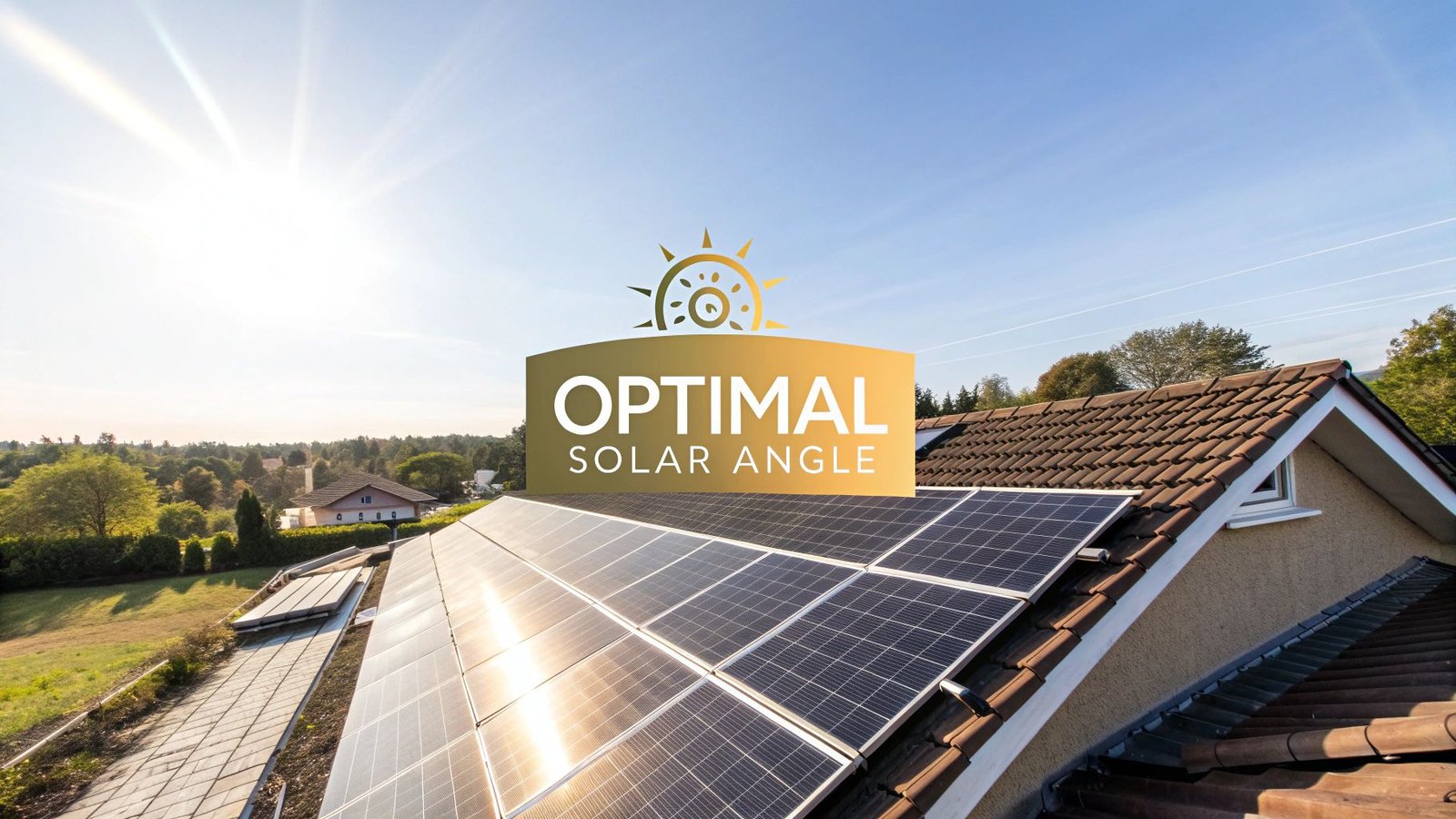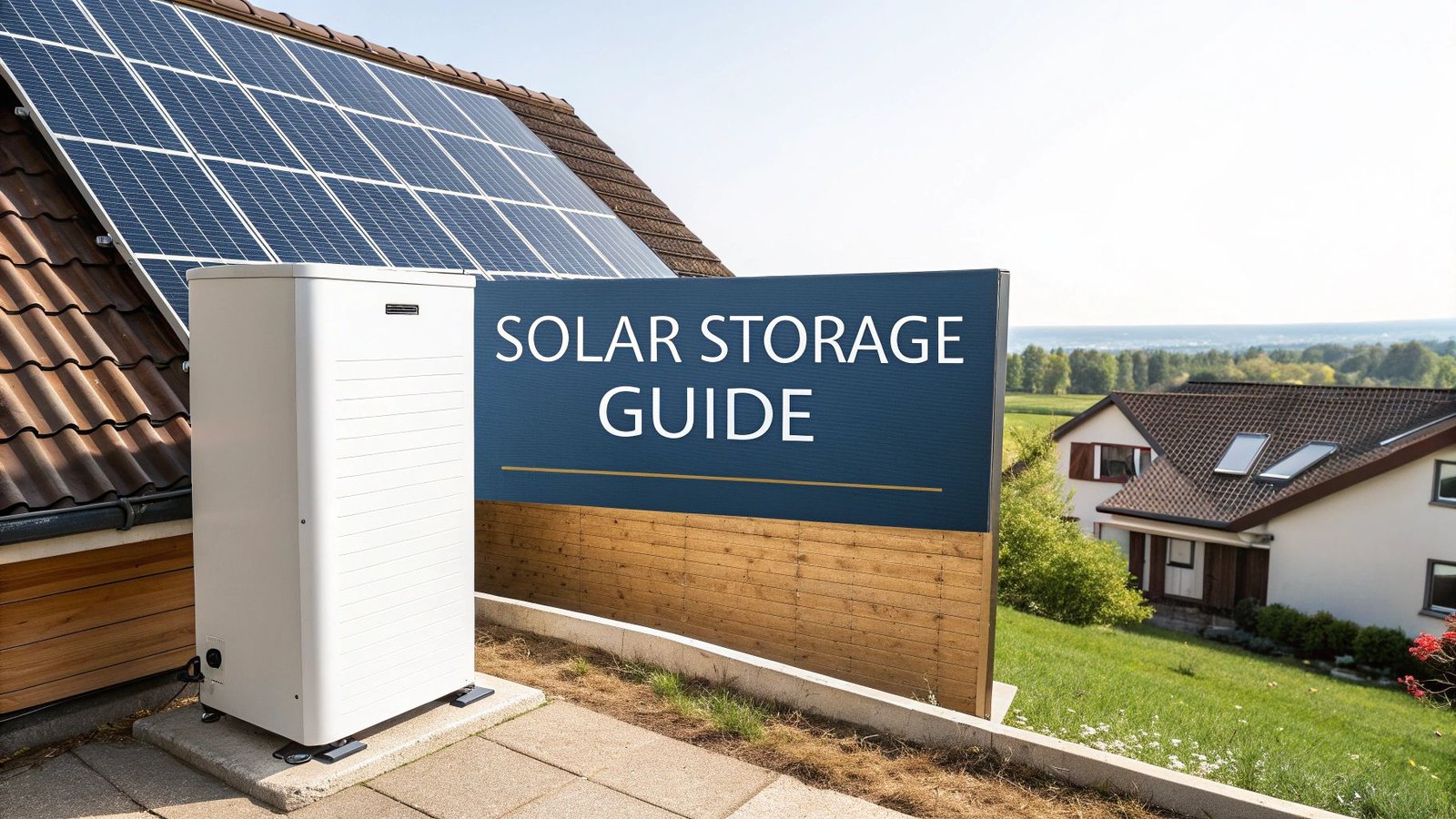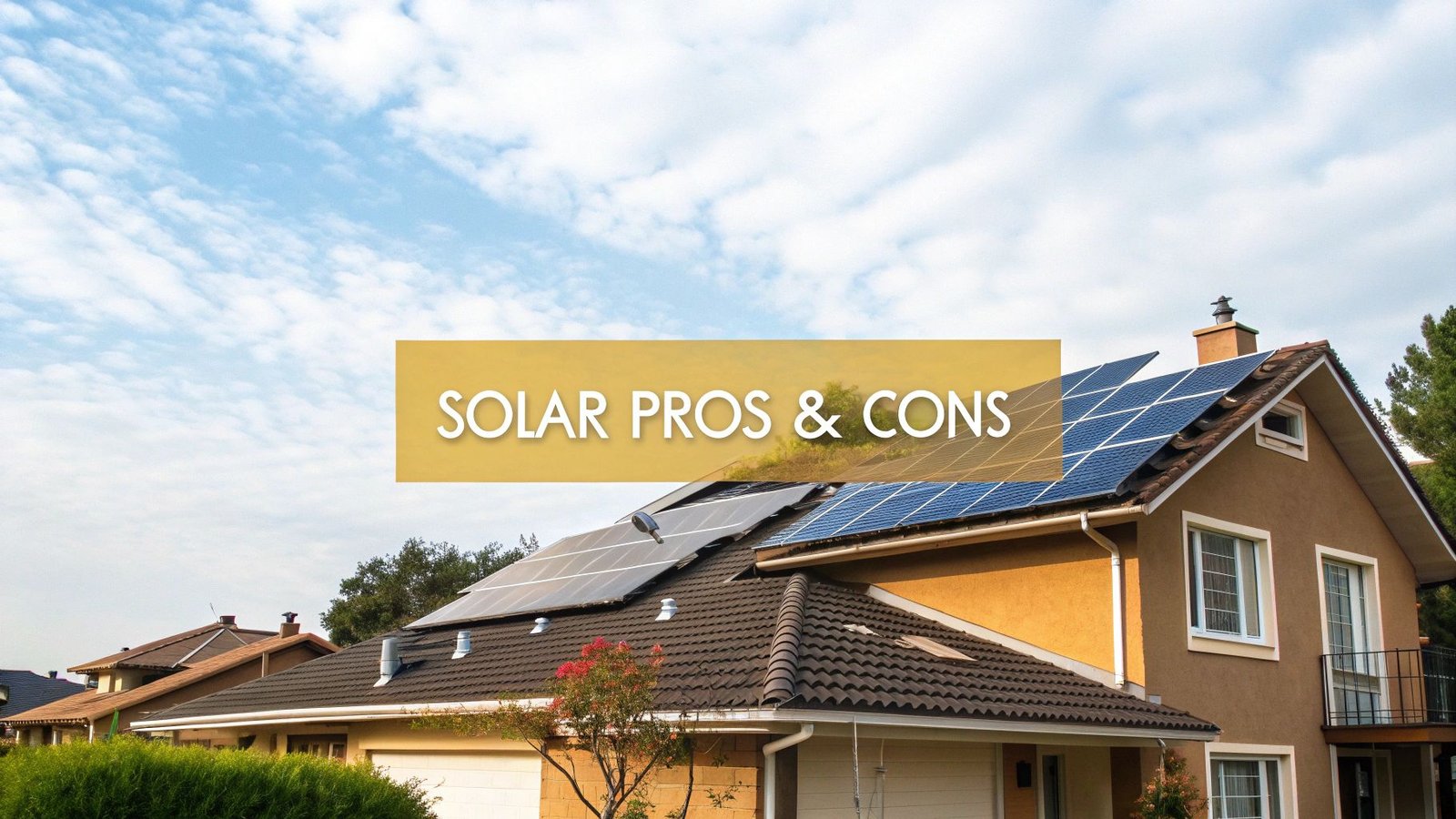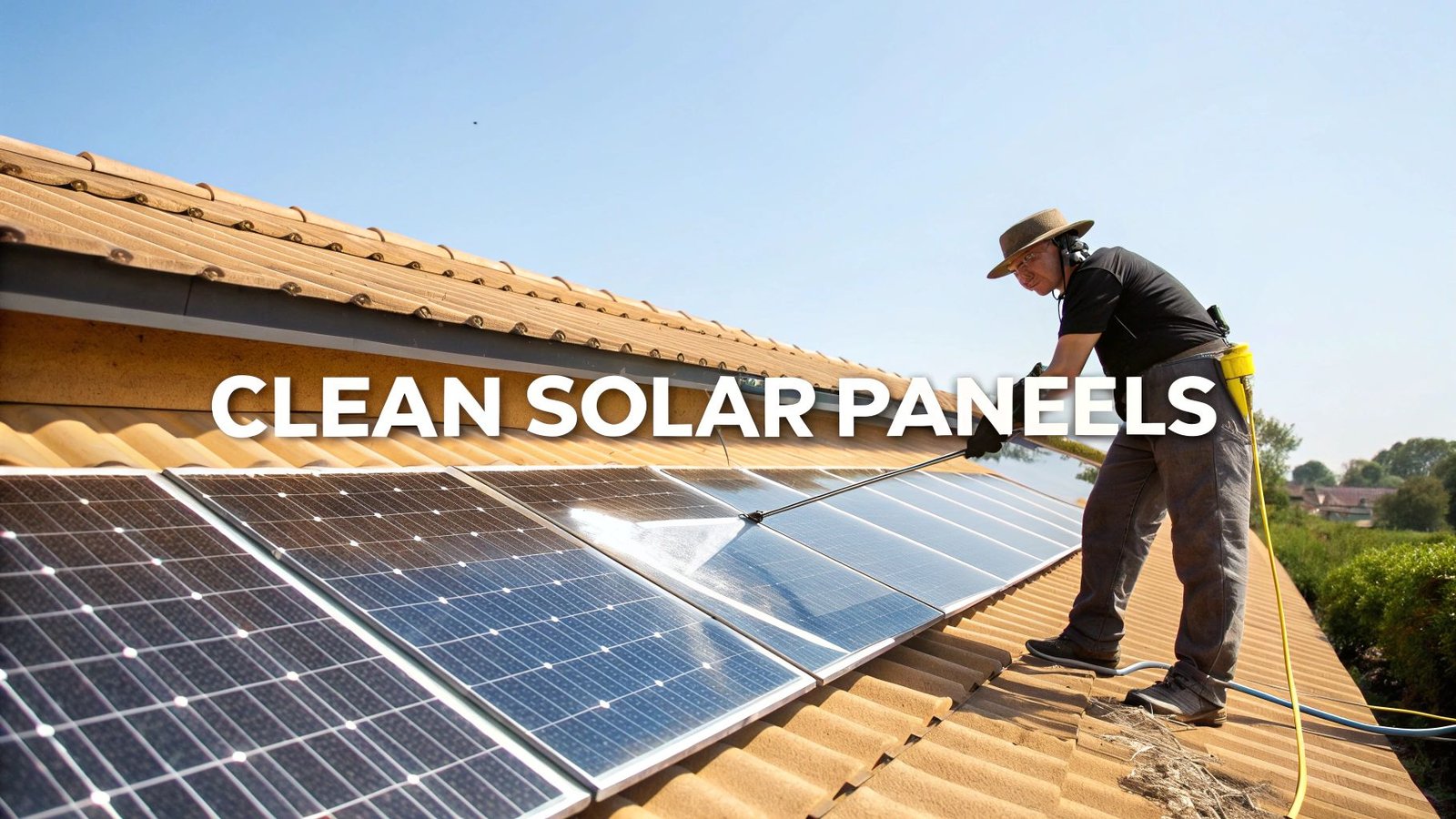If you're in the Northern Hemisphere, the golden rule is simple: point your solar panels true south. For those in the Southern Hemisphere, the opposite is true—your panels should face true north. This fundamental principle aims your array directly at the equator, ensuring it soaks up the maximum amount of sunlight as the sun journeys across the sky each day.
Getting the Basics of Solar Orientation Right
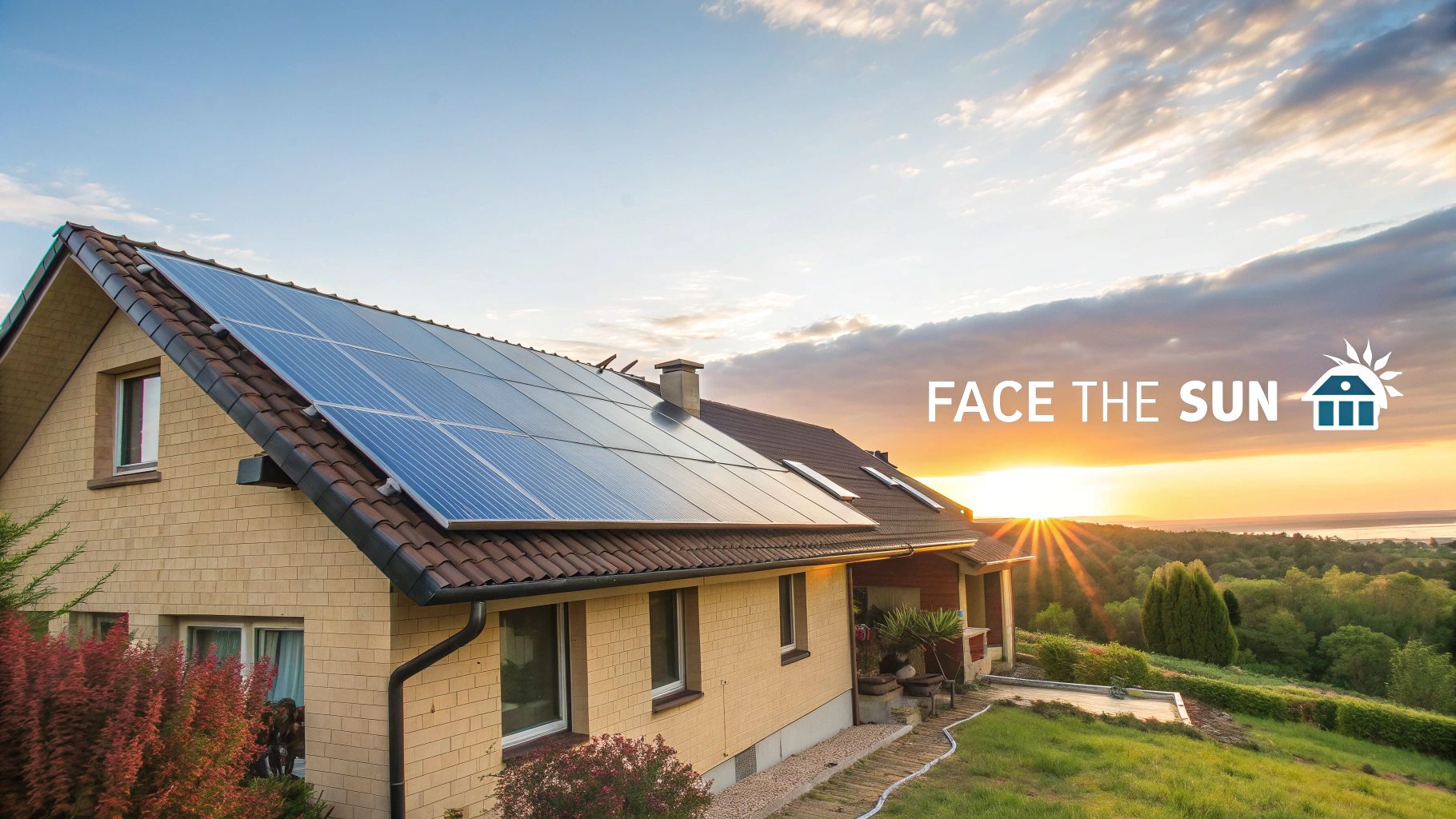
Think of your solar panels like a sunflower, always trying to turn their face toward the sun. Getting this orientation right isn't just a minor detail; it’s the absolute foundation of an efficient home solar system. When your panels are positioned to catch the most direct sunlight for the longest period, you're not just generating power—you're maximizing your investment.
To get this right, we need to look at two key factors that work in tandem:
- Azimuth: This is simply the compass direction your panels are facing—south, east, west, or somewhere in between.
- Tilt: This refers to the angle of your panels in relation to a flat surface, like the ground.
Why Does This Matter So Much?
Nailing the orientation is the single biggest thing you can do to get the most out of your solar panels. For decades, the standard advice has been to face panels south (in the Northern Hemisphere) with a tilt that matches your home's latitude. Getting this right can boost your annual energy production by up to 20% compared to an array that’s poorly positioned. That’s a massive difference in both energy independence and your electricity bill.
If you're curious about your own property, you can explore some fantastic interactive tools, like the Global Solar Atlas provided by the World Bank Group, to see your potential.
At the end of the day, the goal is to capture as many sun rays as possible. The right orientation means your panels are working their hardest for you, turning sunlight into real savings.
To make this crystal clear, here’s a quick guide summarizing the general rules of thumb.
Quick Guide to Ideal Solar Panel Orientation
| Hemisphere | Ideal Direction (Azimuth) | General Tilt Angle Rule |
|---|---|---|
| Northern | True South | Angle equal to your latitude |
| Southern | True North | Angle equal to your latitude |
These simple guidelines are a fantastic starting point. Now that we've covered the basics, we can dive deeper into how azimuth and tilt really work to fine-tune your system for peak performance.
Finding Your Perfect Azimuth for Peak Sunlight
To get the most out of your solar panels, we first need to talk about azimuth. It sounds technical, but it’s really just a fancy word for the compass direction your panels are pointing.
Here in the Northern Hemisphere, the sun spends its entire day traveling across the southern part of the sky. To capture as much of that sunlight as possible, the ideal setup is to face your panels directly toward true south, which is an azimuth of 180°.
Think of it like a sunflower tracking the sun. By pointing your panels where the sun is highest and hangs out the longest, you’re setting them up for peak energy production. More sun means more electricity, and that means bigger savings on your bills. If you're down in the Southern Hemisphere, the same principle applies—you'd just aim for true north instead.
What If Your Roof Isn't Perfect?
Of course, very few homes have a perfectly south-facing roof. If yours points east or west, don't sweat it. You can still see fantastic results from a solar installation.
A slight turn away from true south has a much smaller impact on energy production than most people assume. Modern solar panels are incredibly efficient and can generate a substantial amount of power even when they aren't in that "perfect" spot.
graph TD
subgraph Impact of Azimuth on Annual Production (Northern Hemisphere)
A[True South (180°)] -- 100% --> A
B[South-East / South-West] -- 95% - 98% --> B
C[East / West] -- 85% - 90% --> C
D[North-East / North-West] -- 60% - 75% --> D
end
style A fill:#4CAF50,stroke:#333,stroke-width:2px,color:#fff
style B fill:#8BC34A,stroke:#333,stroke-width:2px,color:#fff
style C fill:#FFC107,stroke:#333,stroke-width:2px,color:#000
style D fill:#F44336,stroke:#333,stroke-width:2px,color:#fff
The goal is to maximize sunlight, but a flawless, south-facing roof simply isn't a deal-breaker. Even east or west-facing panels can produce 85% or more of the energy you’d get from an ideally oriented system. That makes solar a great investment for the vast majority of homeowners.
This infographic really puts it into perspective, showing how a panel's energy output changes as its direction moves away from that ideal equator-facing orientation.
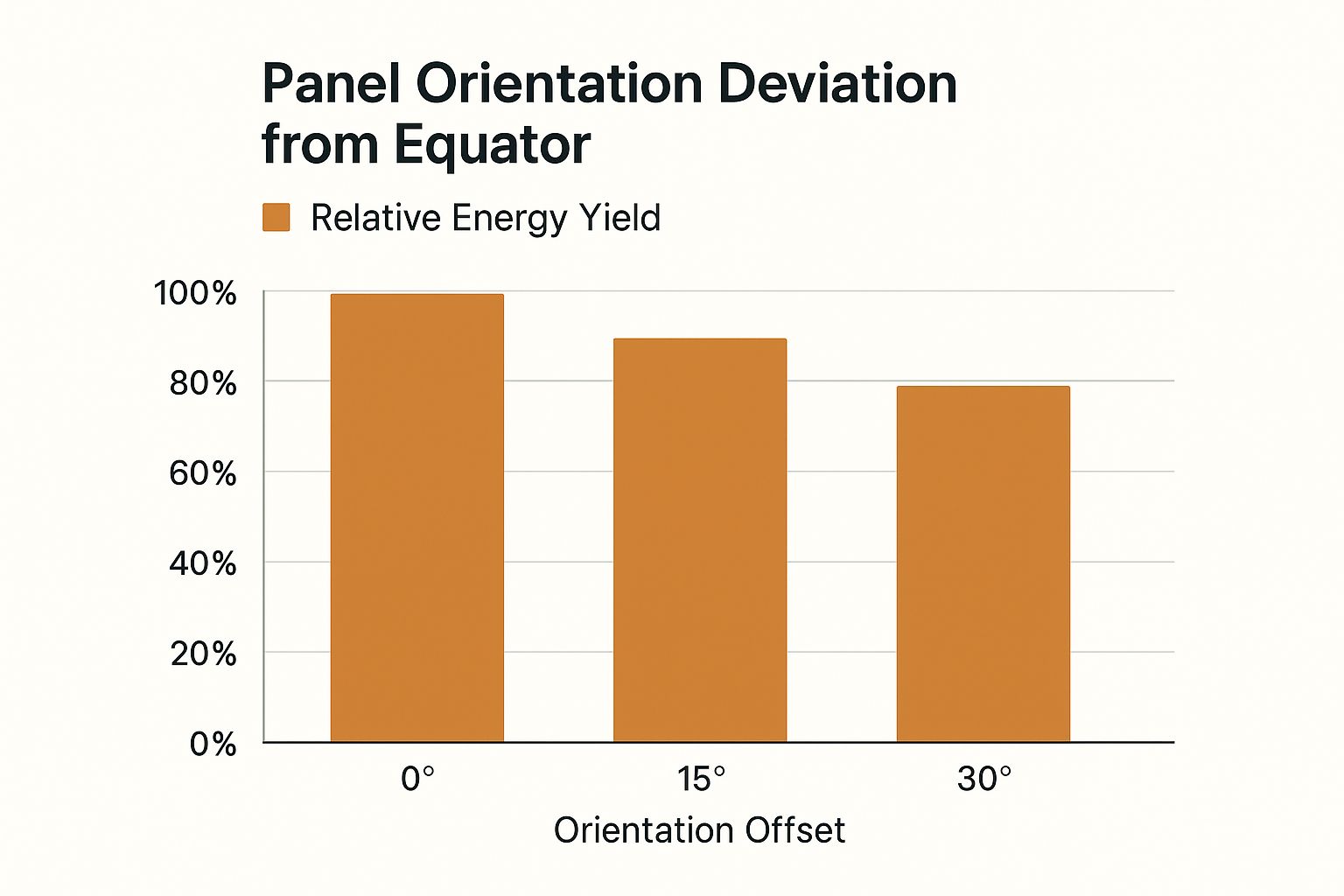
As you can see, being off by 15 degrees barely makes a dent in performance. Even a 30-degree offset still keeps your energy yield incredibly high. It just goes to show that you don't need the perfect roof to get near-perfect results.
Figuring Out the Best Tilt Angle for Your Solar Panels
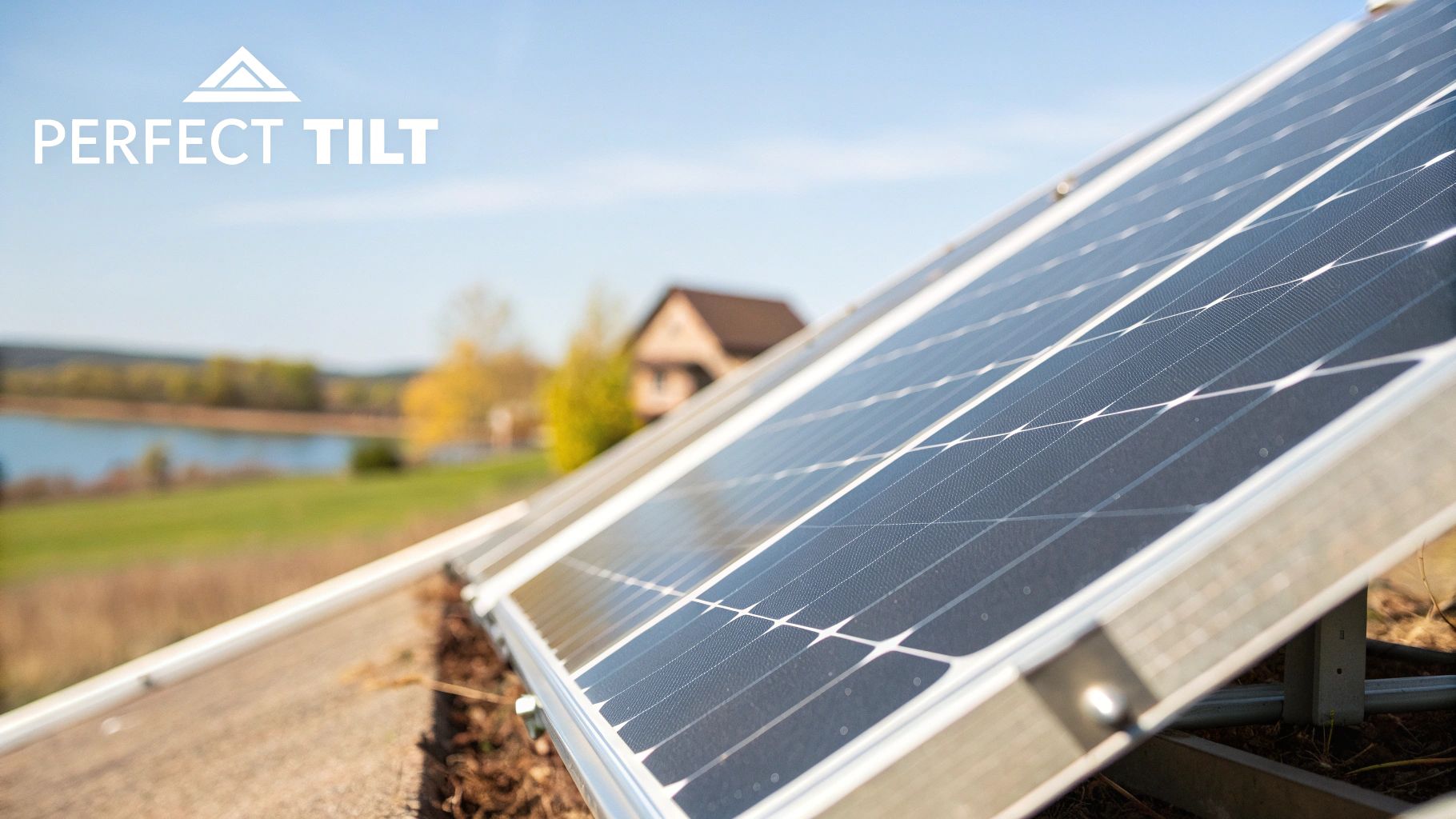
Once you've nailed down which direction your panels should face, the next big piece of the puzzle is the tilt. Think of it this way: you want your panels to be perfectly perpendicular to the sun's rays to catch the most direct, powerful sunlight. The easiest and most reliable starting point is simply matching your panel's tilt angle to your home’s latitude.
For instance, if you live in Denver, Colorado, you’re at a latitude of about 40° North. To get fantastic year-round performance, you'd want to tilt your panels at a 40-degree angle from the ground. This simple trick gives you a great balance, capturing the sun effectively as its position shifts with the seasons.
Fine-Tuning for the Seasons
That "latitude rule" is a solid baseline, but if you want to squeeze every last drop of power out of your system, you can adjust the tilt seasonally. The sun is much lower in the winter sky and sits high overhead in the summer. By tweaking your panel angle, you can chase that sun for maximum energy right when you need it.
Here are three go-to formulas for calculating the best tilt depending on your goals:
- Best All-Around Performance:
Tilt Angle = Your Latitude - Maximum Winter Power:
Tilt Angle = (Your Latitude x 0.9) + 29° - Maximum Summer Power:
Tilt Angle = (Your Latitude x 0.9) - 23.5°
Why the difference? The winter formula gives you a steeper angle to catch that low-hanging sun, which is perfect if you’re using electricity to heat your home. The summer formula does the opposite, creating a flatter angle to face the high sun—a huge help when your AC is running full blast. Diving into solar panel optimization can help you figure out which strategy makes the most sense for your home's energy habits.
Why a Few Degrees Makes a Big Difference
Getting the tilt angle right isn't just for show; it directly impacts how much energy you generate and how much money you save. In a sun-drenched area like the Southwestern USA, optimizing your setup can lead to some seriously impressive results.
Take central Colorado, which gets a whopping 2,000 kWh/m²/year of sunlight. A perfectly positioned panel there can churn out around 400 kWh of electricity annually. In contrast, a less sunny spot like southern England might only generate 175 kWh with the same exact panel. It’s a powerful reminder of how location and orientation work together to determine your system's output.
Dealing with Real-World Roofs and Obstacles
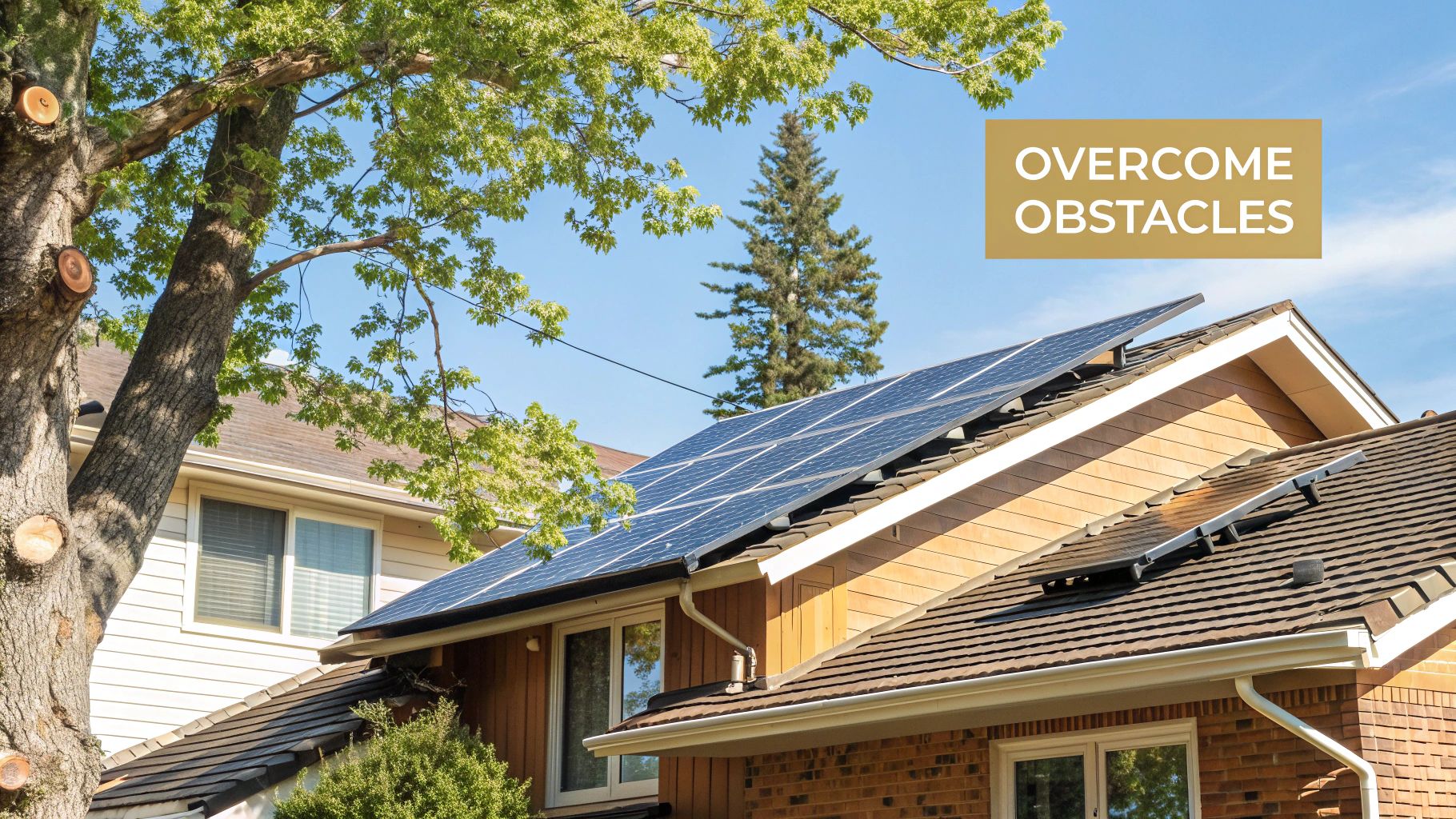
Let's be honest: the "perfect" south-facing roof with an ideal tilt angle is mostly found in textbooks. Most of us live with real-world challenges, whether it's an awkward roof angle, a stubborn chimney, or that beautiful oak tree in the neighbor's yard that casts a shadow every afternoon.
Finding the best orientation for solar panels on your specific property is all about working with what you have. This is where the pros really earn their stripes.
Using specialized tools, installers conduct a detailed shade analysis. They map out exactly how shadows move across your roof not just during the day, but throughout the year. This data is the key to designing a solar array that sidesteps obstructions and keeps every panel soaking up as much sun as possible.
A big myth is that a little shade makes solar impossible. That’s just not true anymore. Modern setups use things like microinverters or power optimizers, which let each panel operate on its own. A shadow on one panel won't drag down the performance of the entire system.
Creative Solutions for Tricky Roofs
So, what do you do when your roof’s layout is more of a puzzle than a perfect canvas? Installers have a few clever tricks up their sleeves to squeeze the most power out of even the most complicated roofs.
- Split Arrays: Can't fit all your panels in one spot? No problem. The array can be split across different roof sections. An east-west split is actually a great strategy, as it catches the early morning sun and the late afternoon sun, spreading out your energy production.
- Ground-Mounted Systems: If you have the yard space, a ground-mounted system is the ultimate solution. It gives you total control over both the direction and tilt, completely avoiding any issues with your roof.
- Strategic Placement: Even on a "good" roof, a pro might carefully place panels to dodge a vent pipe or dormer that would cast a shadow right when the sun is at its strongest.
Of course, before any panels go up, your roof itself needs to be in good shape. It's smart to understand the roof replacement process to make sure you have a solid foundation for the next 25+ years.
There are also specific solar panel roof requirements to consider, which you can read all about in our detailed guide here: https://radiantenergysolar.com/solar-panel-roof-requirements/. Every home is unique, but with a smart design, you can almost always find a way to make solar work wonders.
When an East-West Orientation Makes More Sense
For decades, the "point it at the equator" rule has been the undisputed gold standard for solar panel placement. But our modern lives and energy habits are starting to challenge that old wisdom. The truth is, for many homeowners, a south-facing array that hits its peak output at high noon just doesn't line up with when they actually use the most electricity.
This is exactly where an East-West orientation comes into play. Instead of creating one big energy spike in the middle of the day, this setup gives you two smaller, more useful peaks—one in the morning from the east-facing panels and another in the late afternoon from the west-facing ones. The result is a much broader and more consistent energy supply all day long.
Aligning Power Production with Your Daily Life
Think about your family’s routine on a typical weekday. You see a surge of energy use in the morning as everyone gets ready for work and school. Then things quiet down during the day, only to spike again in the late afternoon and evening when the family returns, flips on the lights, starts cooking, and powers up all their devices.
gantt
title Typical Household Energy Use vs. Solar Production
dateFormat HH
axisFormat %H:00
section Household Energy Use
Morning Peak :crit, a1, 06, 2h
Evening Peak :crit, a2, 17, 4h
section South-Facing Solar
Production Curve: b1, 09, 6h
section East-West Solar
East Production : c1, 07, 4h
West Production : c2, 14, 5h
An East-West system is practically tailor-made for this rhythm. It generates electricity right when you need it most, helping you power your home directly from the sun during those high-demand windows. This becomes a huge advantage, especially if you're on certain utility billing plans.
An East-West solar array produces a steadier stream of energy from sunrise to sunset. This approach can be far more effective at reducing your reliance on the grid during the most expensive times of the day.
The financial upside really clicks into place if your utility company has you on time-of-use (TOU) rates. These plans make electricity more expensive during peak afternoon hours. A west-facing array is your secret weapon here, churning out maximum power right as those costly rates kick in, which can seriously boost your savings. You can get the full scoop on how these plans work in our guide to time-of-use electricity rates.
Making the Most of Your Space
Beyond just matching your energy habits, an East-West orientation is also a smart solution for making the most of limited roof space. It allows for a more compact installation that can fit more panels onto certain roof styles.
While this setup might not wring out every last drop of sunlight compared to a perfectly angled south-facing system, today's technology more than makes up for it. Modern high-efficiency panels—we're talking 20% or higher efficiency ratings—easily offset any minor losses from a less-than-perfect orientation. For more details on this, you can find great insights about solar panel efficiency on GreenMatch. This makes the East-West layout a financially savvy and practical choice for more and more homeowners.
Common Questions About Solar Panel Orientation
Even after getting a handle on the basics, it’s completely normal to wonder how all this applies to your specific house. Let's dig into some of the most frequent questions and concerns homeowners have when figuring out the best orientation for their solar panels.
What Happens If My Roof Doesn't Face South?
Don't worry. If your roof doesn't have that perfect, due-south exposure (in the Northern Hemisphere, of course), you can still generate a ton of solar power. In fact, systems on east or west-facing roofs are not only common but also very effective.
Take a west-facing roof, for example. Those panels are perfectly positioned to soak up the intense, late-afternoon sun. This timing is fantastic because it often lines up with when household energy use spikes—think running the AC, cooking dinner, and turning on lights. This helps you offset power costs when electricity rates are often at their highest.
You might see a 10-20% dip in total yearly generation compared to an ideal south-facing setup, but today's high-efficiency panels can close much of that gap. A qualified installer can run simulations to show you exactly what to expect from your specific roof.
Should I Adjust My Solar Panel Tilt Seasonally?
For almost all residential rooftop solar systems, the answer is a simple "no." The panels are installed at a fixed angle, a sweet spot carefully calculated for great year-round production. Trying to adjust them just isn't practical.
The minor boost you'd get from seasonal tilting is almost always outweighed by the hassle and serious safety risk of getting up on your roof multiple times a year.
That said, for ground-mounted systems or some specific DIY setups with adjustable racks, tweaking the tilt can make sense. A steeper angle in the winter and a shallower one in the summer can squeeze a few extra percentage points of production out of your system, giving you a slight performance edge.
How Much Does Shading Affect My Solar Panels?
Shading is a big deal, and it's something we have to plan for carefully. In the old days of solar, even a small shadow from a tree branch on a single panel could tank the performance of the entire string of panels it was connected to.
Thankfully, modern technology has pretty much solved this headache. We now use solutions like microinverters or DC optimizers. These devices let each panel work independently. So, if a chimney casts a shadow on one panel, the rest of your array keeps cranking out power at its full potential.
During a professional site assessment, an installer will use specialized tools to map out any shading on your roof throughout the day and year. This data helps them design an array that sidesteps those shadows as much as possible, ensuring you get the best possible return on your investment.
Ready to find the perfect solar solution for your unique home? The team at Radiant Energy specializes in designing custom solar systems that maximize energy production, no matter what direction your roof faces. Get your free, no-obligation solar assessment today!

